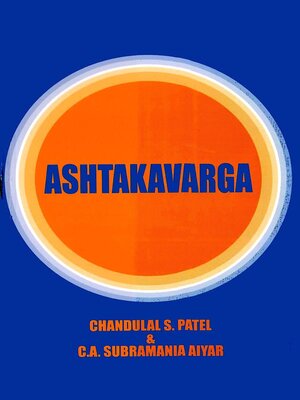
Sign up to save your library
With an OverDrive account, you can save your favorite libraries for at-a-glance information about availability. Find out more about OverDrive accounts.
Find this title in Libby, the library reading app by OverDrive.



Search for a digital library with this title
Title found at these libraries:
| Library Name | Distance |
|---|---|
| Loading... |
The ashtakavarga is recognized as an outstanding system of prediction among the several systems advocated in the standard works on astrology. The present work consisting of about 950 verses from various authorities in a logical format exclusively on ashtakavarga and its practical application. Thus it is an attempt to fulfil this long felt desideratum.
Shri C.S. Patel and Shri C.A.S. Aiyar have compiled and published this treatise on the Ashtakavarge system. The authors of the treatise have given us a full and lucid explanation of thc principles and the modus operandi of the Ashtakavarga in the light of the knowledge garnered from every possible source, with the result that what they are presenting us today is not merely the re-hash of some moth-eaten Sanskrit tome but a critical compendium of all available information on the subject.
Natal astrology consists of two distinct sections. The first section enables us to form a general idea of the sum-total of planetary influences scattered through the different houses of the horoscope, what the stars have in store for the native by way of success and failure. pleasure and pain, fame and notoriety. The second section mainly deals with the time factor governing the planetary and steller influences concealed in the birth chart, the Paka-kala (moment of maturity), as it is technically known, of the promise of the birth chart. The Paka-kala is generally deduced from the periods and sub-periods (Dasas and Antardasas) of planets.
The Ashtakavarge system appears to have originated in the very remote past. Acharya Varahamihira (circa 500 A.D.) mentions it rather casually, as if it had already become an integral part of the standard teaching. on astrology in his day, not requiring a very detailed exposition. It is quite likely, therefore, that the system originated some centuries before Varaha, perhaps a couple of centuries even before Christ.
The system is, no doubt, rather intricate and laborious, and those shallow practitioners who feel that predictions ought to come trippingly to the tongue as soon as one knows the Moon-sign or the Moon's Nakshatra have not been able to appreciate its importance. Consequently it has fallen into disuse in recent years, though at times some practitioners do add a series of bald Ashtakavarga tables, without a word of interpretation, in order to produce an awe-inspiring scroll and fleece the gullible client! Let us hope that the authors of the present volume would succeed in reviving and popularizing this half-forgotten system of the ancients and earn the credit for setting at least one part of the house of astrology in order.







